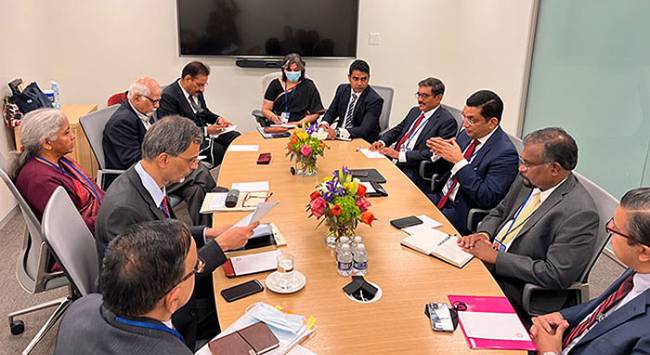Sri Lanka seeks IMF Loan: Implications and Tough Policy Shifts
Iqbal Singh Sevea
21 April 2022Summary
Soaring inflation and a critical shortage of foreign exchange have resulted in Sri Lanka seeking its seventeenth International Monetary Fund loan. This marks a significant shift in the government’s position. Fundamentally, it will also force the government to re-orient its socio-economic policies.
As Sri Lanka grapples with an acute shortage of foreign exchange and soaring inflation, a delegation led by Finance Minister Ali Sabry and the Governor of the Central Bank, Nandalal Weerasinghe, arrived in Washington, United States on 18 April 2022 to negotiate a loan from the International Monetary Fund (IMF). While the quantum of the loan sought has not been specified, Sabry has indicated that Sri Lanka is seeking up to US$4 billion (S$5.4 billion) in loans to tide over its imports for the next six to nine months. If the negotiations are successful, this will be Sri Lanka’s seventeenth loan from the IMF. The attempt to secure an IMF loan marks a major shift in the government’s position and may force it to re-examine its socio-economic policies.
President Gotabaya Rajapaksa’s government has long opposed IMF loans. There was a prevailing view that Sri Lanka had been overly reliant on foreign debts. For instance, the former Central Bank Governor, Ajith Cabraal, had asserted that liquidity in Sri Lanka had dried up partly due to its high foreign debt repayments and that instead of borrowing more from the IMF, the government needed to develop an “alternative strategy”. There were also concerns over implementing economic reforms upon which an IMF loan would be contingent. A number of these would be directly in contrast with the socio-economic policies introduced by the Rajapaksa regime. These include the government’s slashing of the value-added tax from fifteen per cent to eight per cent; raising income tax waivers that decreased the number of taxpayers by approximately 33 per cent; and a range of government subsidies. Such populist policies have been an important part of Rajapaksa’s political platform. Thus, the arrival of the Sri Lankan delegation in Washington signals the severity of the current crisis and the government’s realisation that it may need to usher in drastic policy shifts. The appointment of Weerasinghe, who worked for the IMF as the Head of the Central Bank, is a further indication of this.
In the following days, the Sri Lankan delegation and their counterparts from IMF will discuss the modalities of a possible loan, various means of increasing revenue generation, moderating government expenditures and debt restructuring. Commitment to ensuring fiscal discipline is an important aspect of the IMF loans. The delegation’s agenda will likely include key points such as the introduction of austerity measures, cessation of government subsidies, increasing value added tax rates, devaluation of the currency and the privatisation of some state-owned enterprises. In anticipation of these, Sri Lanka has already increased its interest rates to 14.5 percent and devalued its currency. As the IMF examines a country’s exchange rate, regime and consistency with the aims of expanding exports, the devaluation will make negotiations easier.
Acceptance of the IMF terms may not be well-received in a country that is already confronted by soaring costs and severe shortages. As it is, an inflation rate that is nearing 19 per cent has led to concerns over access to food, fuel and medicine and has led to mass protests against Rajapaksa. The government will need to explain any potential IMF deal to the various opposition parties, trade unions and voters. The government’s recent announcement to default on its external debts was no doubt an attempt to convince its lenders to take a haircut. This timely announcement could also be an endeavour by the government to convince its domestic constituency that its choices are limited to accepting the structural and policy changes that the IMF would recommend, especially on the implementation of austerity measures.
In addition to hoping for an IMF loan, Sri Lanka has initiated discussions with the World Bank for budgetary support. Apart from financing and advisory, the World Bank also provides loans pertaining to human development and poverty reduction. Thus, a potential World Bank loan could be used to bolster the health and educational infrastructure and develop green infrastructure in the coming years. This could help relieve some of the stresses following the implementation of austerity measures.
The big question is not whether Sri Lanka will receive an IMF loan but rather how much. As noted above, Sri Lanka is targetting US$4 billion worth of loans. In 2016, the IMF had agreed to lend US$1.5 billion (S$2.04 billion) to Sri Lanka. However, Sri Lanka only received US$1.3 billion (S$1.77 billion) as it failed to comply with the IMF’s conditions.
Looking ahead, the IMF loan may lead to tough policy shifts that will not be popular. However, Sri Lanka’s attempts to buy time for its tourist economy to rebound through loans and credit facilities from countries like Bangladesh, China and India are not sustainable. Given the lack of an alternative strategy and the growing discontent, the government needs the IMF to rescue it as soon as possible.
. . . . .
Associate Professor Iqbal Singh Sevea is Director at the Institute of South Asian Studies (ISAS), an autonomous research institute at the National University of Singapore (NUS). He can be contacted at isasiss@nus.edu.sg. The author bears full responsibility for the facts cited and opinions expressed in this paper.
Photo Credit : Onlanka Twitter account
-
 More From :
More From :
-
 Tags :
Tags :
-
 Download PDF
Download PDF


